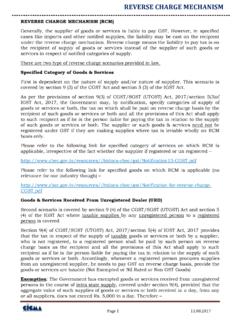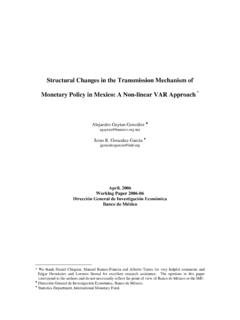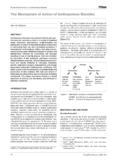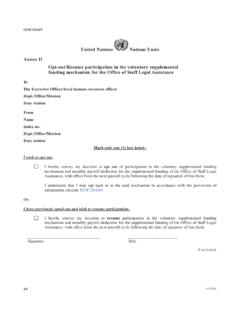Transcription of National Electric Power Regulatory Authority - PPIB
1 National Electric Power Regulatory Authority MECHANISM FOR DETERMINATION OF TARIFF FOR HYDROPOWER PROJECTS Preamble Conservative estimates show total hydroelectric potential in the country to be 45000 MW. This consists of all categories of hydropower plants, including storage-based, run of the river, high head and low head schemes in the mountainous regions, as well as on rivers and canals in the plains. The present installed hydroelectric capacity of 6,608 MW amounts to less than 15% of the identified potential. The present shortage and future growth in electricity not only requires induction of new Power plants in immediate terms but additional capacity is also needed over medium to long term horizon.
2 Hydroelectric being a renewable form of energy is certainly recognized as one of the most attractive options for the future supply mix. Due to their unique nature however, hydropower plants present a number of risks which may be seen as hurdles by the prospective investors to invest in hydropower plants relative to investing in other forms of electricity generation. Cost uncertainty is one of such areas which may render National Electric Power Regulatory Authority ( NEPRA ) tariff determinations ineffective. While recognizing cost uncertainty as a genuine problem NEPRA in order to remove such ambiguities, has developed a mechanism ( Mechanism ) which provides for determination of tariff and subsequent adjustments at different stages of hydropower project development.
3 In this respect three distinct stages have been identified when costs may differ. These costs are; (i) Feasibility Level Costs (ii) EPC Level Costs (iii) Final Costs which shall be no later than the Commercial Operation Date ( COD ) The Mechanism provides for NEPRA s tariff determination based on costs at feasibility study stage and then at EPC stage, adjustable at COD to reflect those changes which have been permitted in the Mechanism. The following sections describe NEPRA s Mechanism for determination of tariff for hydropower projects:- PART I General 2.
4 Purpose:- The purpose of this document is to provide a uniform, transparent, objective and predictable Mechanism and to remove ambiguities, that the sponsors of hydel projects and/or project companies, Power procurers and Power purchasers might have about the steps to be employed by NEPRA in determination of tariff of hydropower projects. This document shall not be read in a manner which undermines or over-rides any provision of NEPRA Act, Rules, Regulations and other applicable documents and in case of any conflict between this document and the NEPRA laws, the latter shall prevail over the former.
5 3. Applicability:-This Mechanism is available to all hydro licenses or Applicants for generation license for constructing, owing, operating or managing of hydro generation facilities which the sole purpose of Power generation, within the jurisdiction of NEPRA. 4. Definitions:- For the ease of understanding, key words used in the Mechanism have been defined for a consistent interpretation. These definitions shall not be read to substitute or replace the meaning assigned to them in NEPRA Act, Rules and Regulations. (a) Act means Regulations of Generation, Transmission and Distribution of Electric Power Act (XL) of 1997, as amended from time to time.
6 (b) Applicant means project sponsors or project companies or hydro license for projects located in Pakistan and Power purchase or procurer for projects located outside the jurisdiction of NEPRA Act who have filed a petition for tariff determination under NEPRA laws. (c) Feasibility Study means feasibility study conducted in accordance with Section-5 of this Mechanism, in the form and manner acceptable to NEPRA, and, where applicable, approved by the Panel of Experts of Private Power and Infrastructure Board (PPIB) in pursuance of Policy for Power Generation Projects, 2002.
7 (d) ECC Decision means the decision of the Economic Coordination Committee of the Cabinet (ECC) dated 22 January 2008, attached here as Annex. (e) NEPRA Laws means the NEPRA Act and Rules and Regulations framed thereunder, together with codes and documents approved by NEPRA. (f) Panel of Experts means consultant(s) or a team of experts appointed by PPIB or other relevant agency to monitor and approve Feasibility Study in respect of the project for which applicant has filed tariff petition. (g) Tariff Reopeners means related costs of project components as identified in the Feasibility Study, which shall, unless approved otherwise, limited to the following; Cost variation due to geological conditions, limited to tunnel area; Civil works cost escalation, and; Resettlement costs.
8 (h) Terms of Reference means the terms of reference for conducting Feasibility Study of hydel project. (i) Commercial Operation Date (COD) As defined under the standard Power Purchase Agreement (PPA) calculated [ to be determined on a case to case basis] Months from the Financial Closing, as such date may be extended pursuant to the terms of PPA or by reason of a Force Majeure Event. PART II Procedural Requirements 5. Feasibility Stage This is the first stage foreseen in the Mechanism for a tariff based on the Feasibility Study of the project.
9 Filing of Application for tariff: The applicant is required to file a petition before NEPRA for determination of its tariff in a form and manner as required under the NEPRA Laws. Completeness of Feasibility Study:- (a) NEPRA will accept only such Feasibility Study which is complete and accurate and, where applicable, supported with a duly signed statement by the Panel of Experts about the quality of the Feasibility Study and performed following best international practices while satisfying the Terms of Reference and the information required under Schedule III to NEPRA (Application and Modification Procedure Regulation, 1999) (b) In addition to pertinent information, the Feasibility Study must include.
10 (i) Item-wise break down of major components of the project, Bill of Quantities (BOQ) and corresponding costs, capacity and energy data and tariff table(s). (ii) A detailed implementation schedule and payment schedule during construction. (iii) Details of Tariff Reopeners. (c) For clarity, following format may be used to show relevant costs and quantities to work out final cost break-down. Other formats can also be used, with the objective to demonstrate transparently the costs and corresponding quantities; No. Item Total Cost in US$ Local Foreign Total A Civil Works A-1 Intake A-2 Tunnels (If applicable) A-3 Power house A-4 Penstock.











